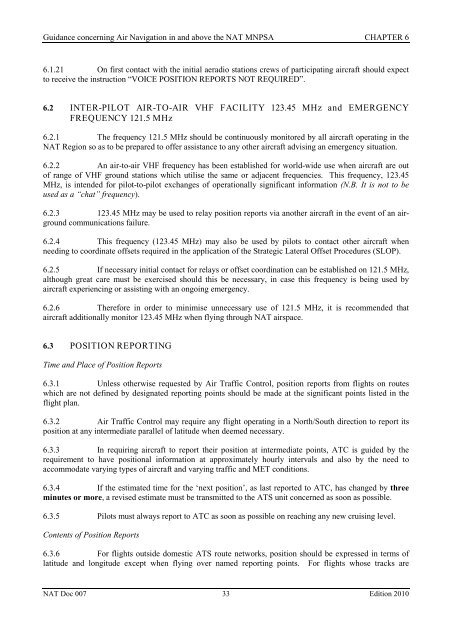World Air Ops | NAT | Doc 007 MNPS Guidance
World Air Ops | NAT | Doc 007 MNPS Guidance
World Air Ops | NAT | Doc 007 MNPS Guidance
You also want an ePaper? Increase the reach of your titles
YUMPU automatically turns print PDFs into web optimized ePapers that Google loves.
<strong>Guidance</strong> concerning <strong>Air</strong> Navigation in and above the <strong>NAT</strong> <strong>MNPS</strong>A CHAPTER 66.1.21 On first contact with the initial aeradio stations crews of participating aircraft should expectto receive the instruction “VOICE POSITION REPORTS NOT REQUIRED”.6.2 INTER-PILOT AIR-TO-AIR VHF FACILITY 123.45 MHz and EMERGENCYFREQUENCY 121.5 MHz6.2.1 The frequency 121.5 MHz should be continuously monitored by all aircraft operating in the<strong>NAT</strong> Region so as to be prepared to offer assistance to any other aircraft advising an emergency situation.6.2.2 An air-to-air VHF frequency has been established for world-wide use when aircraft are outof range of VHF ground stations which utilise the same or adjacent frequencies. This frequency, 123.45MHz, is intended for pilot-to-pilot exchanges of operationally significant information (N.B. It is not to beused as a “chat” frequency).6.2.3 123.45 MHz may be used to relay position reports via another aircraft in the event of an airgroundcommunications failure.6.2.4 This frequency (123.45 MHz) may also be used by pilots to contact other aircraft whenneeding to coordinate offsets required in the application of the Strategic Lateral Offset Procedures (SLOP).6.2.5 If necessary initial contact for relays or offset coordination can be established on 121.5 MHz,although great care must be exercised should this be necessary, in case this frequency is being used byaircraft experiencing or assisting with an ongoing emergency.6.2.6 Therefore in order to minimise unnecessary use of 121.5 MHz, it is recommended thataircraft additionally monitor 123.45 MHz when flying through <strong>NAT</strong> airspace.6.3 POSITION REPORTINGTime and Place of Position Reports6.3.1 Unless otherwise requested by <strong>Air</strong> Traffic Control, position reports from flights on routeswhich are not defined by designated reporting points should be made at the significant points listed in theflight plan.6.3.2 <strong>Air</strong> Traffic Control may require any flight operating in a North/South direction to report itsposition at any intermediate parallel of latitude when deemed necessary.6.3.3 In requiring aircraft to report their position at intermediate points, ATC is guided by therequirement to have positional information at approximately hourly intervals and also by the need toaccommodate varying types of aircraft and varying traffic and MET conditions.6.3.4 If the estimated time for the ‘next position’, as last reported to ATC, has changed by threeminutes or more, a revised estimate must be transmitted to the ATS unit concerned as soon as possible.6.3.5 Pilots must always report to ATC as soon as possible on reaching any new cruising level.Contents of Position Reports6.3.6 For flights outside domestic ATS route networks, position should be expressed in terms oflatitude and longitude except when flying over named reporting points. For flights whose tracks are<strong>NAT</strong> <strong>Doc</strong> <strong>007</strong> 33 Edition 2010
















